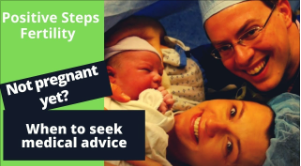In the season of trick or treating, it can be easy to get tricked by spooky fertility myths and legends that have become popular over the years. For couples trying to conceive, a forced schedule for relations can take away some of the magic that might otherwise be present. There are several fertility myths that when dispelled, can improve your ability to become pregnant.
What are some of the most common fertility myths?
Fertility Myth #1: Frequency and Scheduling
Myth: You must have relations every day for peak fertility (myth).
Reality: Sperm live 72 hours, so roughly if a couple has relations twice a week in the week or two around the middle of the cycle (if regular), that can go a long way for increasing your odds of getting pregnant.
Fertility Myth #2: Lubricants
Myth: Lubricants can make sperm more slippery and help them get where they need to be.
Reality: Most lubricants kill sperm, so make sure to get a “sperm-friendly” lubricant if using them.
Fertility Myth #3: Frequency During the Days of Ovulation
Myth: You must have relations as many times as possible on the day of ovulation.
Reality: Having seen couples where both were sore to the point of barely being able to walk when acting on this myth, it is not necessary. Insemination often can double or triple pregnancy rates when increasing sperm counts fiftyfold. If it takes a fifty-fold increase to slightly increase chances an extra round or two on a day doesn’t seem to help much. (The contrary argument is “It can’t hurt,” and if both of you are in the mood, go for it!)
Fertility Myth #4: The Shettles Method for Preferred Gender
Myth: Sex at almost the exact time of ovulation favors a boy, while 2 ½-3 days before favors a girl (the Shettles method).
Reality: A landmark paper in the New England Journal of Medicine did not show a clear benefit, so the timing you choose relative to ovulation most likely makes the chances of a boy or girl 50/50.
Fertility Myth #5: Foods and Medications for Increased Fertility
Myth: Eating pineapple, taking Geritol, or drinking Robitussin can help fertility.
Reality: Though a lot of people have had a drink or two leading to conception, beyond creating opportunity, more than one alcoholic drink a day can lower pregnancy rates.
Similarly, many of the diets or supplements that many say led to their having a child were a coincidence, where they would have been pregnant without taking them.
Studies have dismissed pineapple, Geritol, and Robitussin helping. In fact, taking Robitussin-D can dry out cervical mucus, making it harder to conceive. Some also worry about the caffeine in chocolate having a negative effect. Pregnancy rates are lower with over 200 mg of caffeine a day which is 20 oz of home-brewed coffee, but there is only 5 mg of caffeine per ounce of chocolate. If you are eating over three pounds of chocolate per day, caffeine-associated subfertility may not be your most important health issue.
In short, if trying to conceive, have fun but there is not that much you can do to control it. (It is hard to make it better or worse on your own.)
If the stress of subfertility (conception taking longer than what is typically expected) starts becoming too much or you want to be more assertive about becoming a parent, consult with a specialist. There are lots of things specialists can do for testing and treatment to help you on your journey.
If you are confused or suffering in silence, don’t get tricked by fertility misinformation. Get help and answers to your questions. We are here to help.
Have a wonderful Halloween from all of us here at Positive Steps Fertility!




